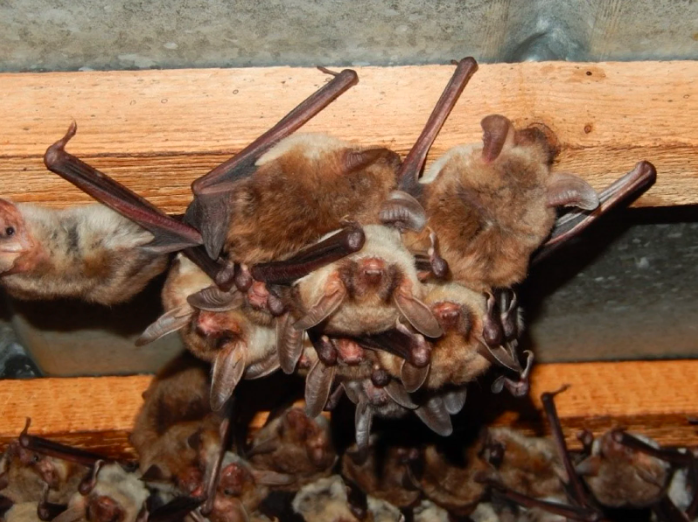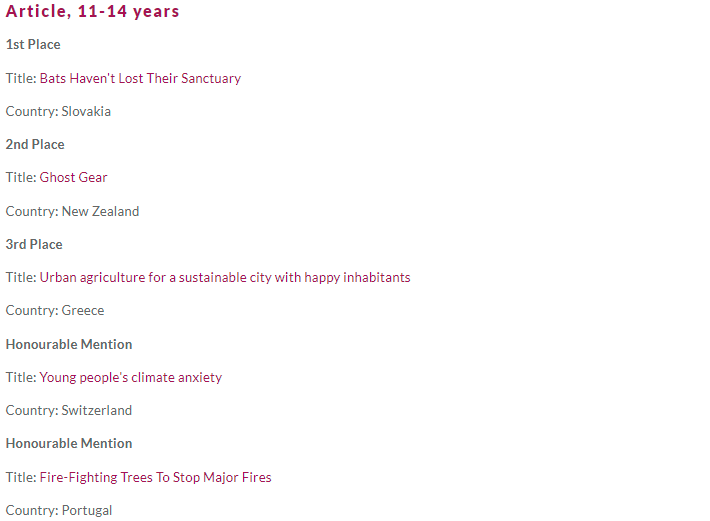YRE Competition 2022
1st Place - Article
11-14 years old
By Cintia Izabela Mrvová, Hana Holbusová
RESIDENTS OF AN APARTMENT BUILDING IN HORNÉ LADCE, A VILLAGE IN WESTERN SLOVAKIA, FOUND THAT THEY HAVE A LOT OF NEW NEIGHBOURS. A COLONY OF BATS HAD SETTLED IN THE ATTIC OF THE THREE-STORY APARTMENT BUILDING. AN ORDINARY RENOVATION OF THE APARTMENT BUILDING BECAME AN ECO-PROJECT UNDER THE SUPERVISION OF ZOOLOGISTS AND THE MINISTRY OF ENVIRONMENT.
The Greater Mouse-Eared Bats found their home in the attic of an apartment building in Horné Ladce more than a year ago. According to Danka Palkechová, an environmentalist who manages protected animals on construction sites, this is a real flying treasure in every sense of the word: "The Greater Mouse-Eared Bat (Myotis myotis), which was found during the inspection, belongs among species of European importance in accordance with the Decree of the Ministry of Environment of the Slovak Republic No. 24/2003 Coll., as amended, and the social value of this species is set at 460 euro each, which means a colony of 325 individuals is valued at 149,500 euro."
In her view, bats are also important because they feed on insects and other invertebrates active during the night, fulfilling an irreplaceable role that diurnal animals cannot. Bats are important in another practical way – they are an indicator of the quality of an ecosystem. They give birth only once a year, have a low number of pups, and have a long lifespan. Such animals cannot quickly regenerate their populations after suffering negative environmental impacts (e.g. chemical pollution, disruption of the food chain, loss of shelter, physical destruction). Their presence or absence in the environment, or changes in the number of individuals indicate the environment's overall quality - therefore they are referred to as bioindicators. In the tropics and subtropics they also serve as pollinators of fruit trees.
The size of the bat colony was registered by residents only when they planned to renovate the apartment building. Ivana Mrvová, chairwoman of the homeowners community, informed us about how the residents handled this situation: "It was not too much of a surprise. We knew there were bats in the attic. We just didn't know how rare they were, how many there were and how their presence would affect the renovation of the apartment building. When applying for a building permit, an ornithologist's report on the reconstruction is mandatory. We were really surprised by the review." The study says that hidden in the attic is the largest maternal colony of the Greater Mouse-Eared Bat in an artificial environment in Slovakia. It is a really great rarity and the scientific community, the Ministry of the Environment, and the public have become interested in bats.
That is nice on the one hand, but on the other hand reconstruction was conditional on renovating the bats' shelter. The reconstruction company built a shelter of organic materials in the attic and the original hanging beams. There are also safe ways for the bats to fly in and out. The entire reconstruction was carried out when the bats were in their wintering grounds. Zoologists had to be consulted every step of the way. However, the unpleasant surprise was that the cost was significantly increased (by approximately €20,000) and the time for reconstruction was reduced. However, this did not deter the inhabitants of the apartment building.
They were aware of the subsidies and challenges, which, although suspended during COVID-19 pandemic, would be implemented in the near future. They could cover all the expenses associated with the construction of the nesting site. Residents of the apartment building are also facing responsibilities in the future. As Mrs Mrva told us: 'This is a significant colony of bats, it will be regularly monitored by zoologists, so we cannot afford any misdeeds. But since the nesting site is well secured, I don't suppose there's a problem with that. We cannot smell or hear the bats in the hallway, and they don't really limit anyone. Let them live happily with us."
In the event of a situation similar to the one in which the inhabitants of Horné Ladce found themselves, the municipal environmental department should be contacted. The process this apartment building went through is a good example of how to support the coexistence of animals and people.
BAT COLONY
The largest mother colony of the great bat in the artificial environment in Slovakia resided in the attic of the residential house. Photo: Roman Lehotský
A LIVING TREASURE
In the attic of the apartment building. Photo: Roman Lehotský
REFERENCES:
website of the Association for Bat Protection in Slovakia https://netopiere.sk/sk/page/ochrana.html
DISSEMINATION
http://www.gymdb.sk/aktuality/kopia-mladi-reporteri.html?page_id=4814
http://www.mladireporteri.sk/clanok/netopiere-nestratili-svoje-utocisko
https://www.facebook.com/hana.holbus1511
https://www.ladce.sk/vzacne-netopiere-v-ladcoch/
https://www.enviroportal.sk/clanok/mladi-reporteri-maju-svojho-vitaza



